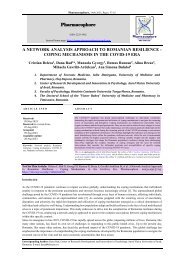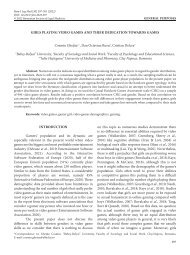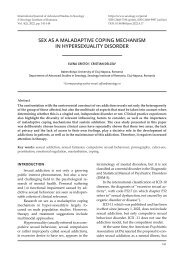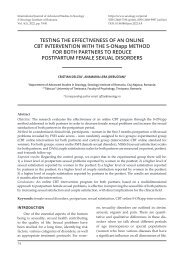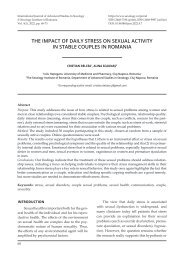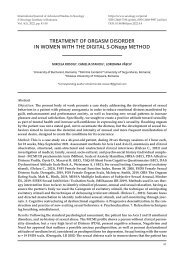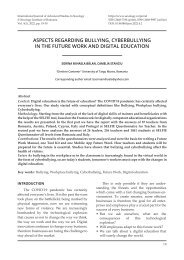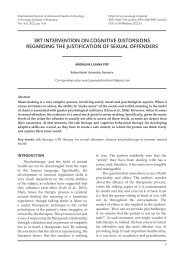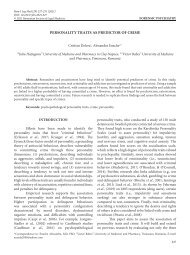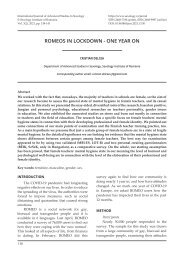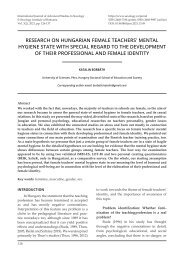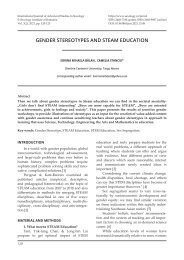THE RELATIONSHIP BETWEEN PERSONALITY DISORDERS AND DOMESTIC VIOLENCE IN FORENSIC CONTEXT
Aim, methods and outcomes. In this research, the mediators of domestic violence were approached from psychological, psychiatric, and forensic theoretical-experimental paradigm perspective, but also by studying working hypotheses issue regarding correlations between mediators (personality disorders) and participants’ behavioral output from experimental perspective. The research included 3 samples: 2 control samples and one experimental sample. These are part of the Institute of Forensic Medicine of Cluj-Napoca database. The gross results of examined patients revealed psychiatric morbidity and co-morbidity, personality disorders and psychiatric disorders absence at the time of forensic psychiatric examination. Results. The following statistical data were obtained from a total of N120 respondents: significant results were obtained (GVD, GDD and GM) F = 25,465, Sig. 0,000 in multiple comparisons using the ANOVA method on independent samples; significant results were obtained for mixed analysis of variance ANOVA two-way on GVD and GM groups F 25,465, Sig. 0.000; and good results weren’t obtained for GVD and GDD groups F 0.453, Sig. 0.503; whereas no significant results were obtained for the Test of Homogeneity of Variances Levene Statistic 0.295 and Sig. 0,589; and significant scores of KMO 0.477 and Sig. 0.000 were obtrained to the statistical method KMO and Bartlett’s Test regarding the eligibility of study participants. Clinical implications and Conclusion. Our research confirms the transdiagnostic approaches from literature perspective about the eight variables of criminal risk regarding domestic violence: history of deviant behavior, antisocial personality pattern, psychopathological cognitive schemas, parental antisocial model, education/ work, leisure / recreation, substances abuse. The correlation/ mediator of domestic violence is the morbidity/ co-morbidity of personality disorders. Our proposal is developing new assessment tools and testing mental and personality disorders in order to be used effectively within the forensic psychiatric committees.
Aim, methods and outcomes. In this research, the mediators of domestic violence were approached
from psychological, psychiatric, and forensic theoretical-experimental paradigm perspective, but also by studying working
hypotheses issue regarding correlations between mediators (personality disorders) and participants’ behavioral output from
experimental perspective. The research included 3 samples: 2 control samples and one experimental sample. These are part
of the Institute of Forensic Medicine of Cluj-Napoca database. The gross results of examined patients revealed psychiatric
morbidity and co-morbidity, personality disorders and psychiatric disorders absence at the time of forensic psychiatric
examination.
Results. The following statistical data were obtained from a total of N120 respondents: significant results were
obtained (GVD, GDD and GM) F = 25,465, Sig. 0,000 in multiple comparisons using the ANOVA method on independent
samples; significant results were obtained for mixed analysis of variance ANOVA two-way on GVD and GM groups F 25,465,
Sig. 0.000; and good results weren’t obtained for GVD and GDD groups F 0.453, Sig. 0.503; whereas no significant results were
obtained for the Test of Homogeneity of Variances Levene Statistic 0.295 and Sig. 0,589; and significant scores of KMO 0.477
and Sig. 0.000 were obtrained to the statistical method KMO and Bartlett’s Test regarding the eligibility of study participants.
Clinical implications and Conclusion. Our research confirms the transdiagnostic approaches from literature
perspective about the eight variables of criminal risk regarding domestic violence: history of deviant behavior, antisocial
personality pattern, psychopathological cognitive schemas, parental antisocial model, education/ work, leisure / recreation,
substances abuse. The correlation/ mediator of domestic violence is the morbidity/ co-morbidity of personality disorders. Our
proposal is developing new assessment tools and testing mental and personality disorders in order to be used effectively within
the forensic psychiatric committees.
Create successful ePaper yourself
Turn your PDF publications into a flip-book with our unique Google optimized e-Paper software.
Rom J Leg Med [28] 166-171 [2020]<br />
DOI: 10.4323/rjlm.2020.166<br />
© 2020 Romanian Society of Legal Medicine<br />
<strong>FORENSIC</strong> PSYCHIATRY<br />
<strong>THE</strong> <strong>RELATIONSHIP</strong> <strong>BETWEEN</strong> <strong>PERSONALITY</strong> <strong>DISORDERS</strong> <strong>AND</strong> <strong>DOMESTIC</strong> <strong>VIOLENCE</strong><br />
<strong>IN</strong> <strong>FORENSIC</strong> <strong>CONTEXT</strong><br />
Radu Popa-Nedelcu 1 , Cristian Delcea 2,* , Costel Siserman 2 , Carmen Domnariu 1<br />
1<br />
“Lucian Blaga” University, Sibiu, 2 “Iuliu Hatieganu” University of Medicine and Pharmacy, Cluj-Napoca, Romania<br />
Abstract: Aim, methods and outcomes. In this research, the mediators of domestic violence were approached<br />
from psychological, psychiatric, and forensic theoretical-experimental paradigm perspective, but also by studying working<br />
hypotheses issue regarding correlations between mediators (personality disorders) and participants’ behavioral output from<br />
experimental perspective. The research included 3 samples: 2 control samples and one experimental sample. These are part<br />
of the Institute of Forensic Medicine of Cluj-Napoca database. The gross results of examined patients revealed psychiatric<br />
morbidity and co-morbidity, personality disorders and psychiatric disorders absence at the time of forensic psychiatric<br />
examination.<br />
Results. The following statistical data were obtained from a total of N120 respondents: significant results were<br />
obtained (GVD, GDD and GM) F = 25,465, Sig. 0,000 in multiple comparisons using the ANOVA method on independent<br />
samples; significant results were obtained for mixed analysis of variance ANOVA two-way on GVD and GM groups F 25,465,<br />
Sig. 0.000; and good results weren’t obtained for GVD and GDD groups F 0.453, Sig. 0.503; whereas no significant results were<br />
obtained for the Test of Homogeneity of Variances Levene Statistic 0.295 and Sig. 0,589; and significant scores of KMO 0.477<br />
and Sig. 0.000 were obtrained to the statistical method KMO and Bartlett’s Test regarding the eligibility of study participants.<br />
Clinical implications and Conclusion. Our research confirms the transdiagnostic approaches from literature<br />
perspective about the eight variables of criminal risk regarding domestic violence: history of deviant behavior, antisocial<br />
personality pattern, psychopathological cognitive schemas, parental antisocial model, education/ work, leisure / recreation,<br />
substances abuse. The correlation/ mediator of domestic violence is the morbidity/ co-morbidity of personality disorders. Our<br />
proposal is developing new assessment tools and testing mental and personality disorders in order to be used effectively within<br />
the forensic psychiatric committees.<br />
Key words: domestic violence, personality, psychiatric morbidity, forensic medicine.<br />
<strong>IN</strong>TRODUCTION<br />
Domestic violence is a common, serious and<br />
potentially destructive situation. It can be defined as<br />
any king of aggression - verbal, emotional, mental,<br />
sexual, financial - exerted on a family member. Being<br />
extremely widespread, it has been integrated among the<br />
public health issues at a global level. Considered to be<br />
pandemic in nature, the World Health Organization has<br />
declared it a public health issue and has been involved<br />
in monitoring and evaluating these conditions, trying<br />
to find the best ways to stop the phenomenon [1].<br />
It is well known that, it frequently leaves special<br />
consequences, and the most serious ones can be of a<br />
somatic, psychological, economic or social nature.<br />
In general, when discussing domestic violence,<br />
we indicate two entities: the aggressor and the victim.<br />
There are various theories about each.<br />
First of all we have to think about the victim.<br />
In addition to the measures to be taken as quickly as<br />
possible, namely those regarding to his/her immediate<br />
state of health, the necessary support related to the<br />
legal, psychological and administrative context must<br />
be provided. Once the medical part which is a priority<br />
is resolved as we have indicated, we can also focus<br />
on the emotional and mental status of the person<br />
concerned and on the other unwanted effects. We will<br />
refer to the psychological element. It is not uncommon<br />
for victims to be abused because they suffer from a<br />
psychological disorder. People immediately around<br />
them don’t behave in an appropriate manner for these<br />
conditions which they do not recognize and thus they<br />
*Correspondence to: Cristian Delcea, “Iuliu Hatieganu” University of Medicine and Pharmacy, Cluj-Napoca, Romania, E-mail:<br />
cristian.delcea.cj@gmail.com<br />
166
The relationship between personality disorders and domestic violence in forensic context<br />
are never approached. Another common situation<br />
is that the aggressed person develops an addictive<br />
personality disorder [2]. Any action of submission,<br />
control, humiliation, inferiority or imposition of ideas<br />
may contribute to the condition described above.<br />
Another way of causing seriously harm to the victim<br />
is the defence mechanism called identification with<br />
the aggressor. In this common indeed pathology, it<br />
is noted that the aggressed person tends to stand up<br />
for the abuser and don’t take a stand to get out of the<br />
unpleasant situation. Depressive typology, loss of selfesteem<br />
and sad mood come together and can reach up<br />
to post-traumatic stress syndrome [3].<br />
Alcohol use and personality disorders are<br />
frequently associated with the aggressor. It is known that<br />
alcohol abuse catalyses disturbance actions and there<br />
is an obvious correlation between aggression and the<br />
degree of alcoholism [4]. Alcohol stimulates disinhibition<br />
and stops self-control by triggering impulses of anger<br />
that becomes uncontrollable. In addition to the other<br />
negative effects caused of harmful alcohol consumption,<br />
we highlight domestic violence among the most serious.<br />
Another hypothesis, thus confirmed about the aggressor,<br />
is the one related to personality disorders that have<br />
the same effect, to provoke or maintain the conflicting<br />
states [5]. Listed below are some of the more common<br />
personality disorders: schizoid, antisocial and borderline<br />
personality disorder [6]. However, most people with<br />
personality disorders have never been violent and will<br />
never be.<br />
Those who fall within the schizoid typology are<br />
usually people who tend to be alone, who don’t initiate<br />
contact with the people around them, being concerned<br />
about objects rather than people. They can hide an<br />
internal state of irritability that can erupt brutally<br />
under certain conditions. Also, they can have paranoid<br />
features that might manifest in domestic violence [7].<br />
It is clear why people suffering from antisocial<br />
personality disorder produce violent family events.<br />
Their actions don’t comply with the daily norms of the<br />
community and they act reprehensible [8]. Their actions<br />
can be characterized by abusive, intimidating, stressful,<br />
aggressive behaviour. Or, in these circumstances, often<br />
domestic violence consists solely of verbal part, but<br />
there are raptures that become physical aggression.<br />
Both women and men who manifest any kind<br />
of violence suffer from borderline personality more<br />
often than general population. Borderline personality<br />
disorder is a combination of all other psychopathological<br />
disorders. For this reason, it doesn’t<br />
keeps up a strictly behavioural pattern having various<br />
elements, and its prevalence doesn’t take into account<br />
gender, age or social environment. Thus it is found in<br />
all types of communities. The affected persons face<br />
difficulties in controlling the sudden impulses without<br />
weighing the consequences or they have affective<br />
dysfunctions with sudden and uncontrolled reactions<br />
towards the people immediately around them [9].<br />
Domestic violence is a learned behavioural<br />
pattern. It represents a learned attitude and has<br />
disastrous effects on society. It is also difficult to<br />
annihilate. Personality disorders are most often the<br />
causes of this situation. That is why we must face the<br />
phenomenon on all levels, one of them being related to<br />
the psychological aspect, a situation from which it can<br />
be relatively easily approached, cognitive-behavioral<br />
therapy often achieving success in this purpose [10].<br />
METHOD <strong>AND</strong> PROCEDURE<br />
Participants<br />
The participants were selected from the<br />
Institute of Forensic Medicine of Cluj-Napoca database.<br />
From N1230, only N120 were selected. The selection<br />
criteria were gender (50% female F = 60 female; 50%<br />
male F = 60 male), age (mean age = 36.23 m and SD =<br />
9.93), educational level (m = 2 and SD = 0.02) (Table 1).<br />
Control group 1 (co-morbidity, M)<br />
From the control group 1 only the persons<br />
who met the eligibility criteria for control group 1<br />
(comorbidity) were selected / extracted from the IML<br />
Cluj-Napoca database. N40 persons were identified of<br />
Table 1.<br />
Statistics<br />
SexVD AgeVD SexDD AgeDD SexM AgeM LEVD LEDD LEM<br />
N<br />
Valid 40 40 40 40 40 40 40 40 40<br />
Missing 0 0 0 0 0 0 0 0 0<br />
Mean 50%f/ 50%m 34.70 50%f/ 50%m 39.23 50%f/ 50%m 37.70 1.58 1.53 1.35<br />
Std. Error of Mean 1.210 1.470 1.170 .087 .080 .076<br />
Std. Deviation 7.650 9.300 7.401 .549 .506 .483<br />
Variance 58.523 86.487 54.779 .302 .256 .233<br />
Range 28 35 26 2 1 1<br />
167
Popa-Nedelcu R. et al.<br />
which 50% female F = 40 female; 50% male F = 40 male<br />
with a mean age of = 37.70 m and SD = 7,401, and the<br />
educational level was m = 1.35 and SD = 0.483).<br />
Control group 2 (acts of disposition, DD)<br />
From the control group 2 only the persons<br />
who met the eligibility criteria for the control group<br />
2 (disposition documents) were selected / extracted<br />
from the IML Cluj-Napoca database. N40 persons were<br />
identified of which 50% female F = 40 female; 50%<br />
male, F = 40 male with a mean age of = 39.23 m and SD<br />
= 9,300, and the educational level was m = 1.53 and SD<br />
= 0.506).<br />
Control group 3 (domestic violence, VD)<br />
From the control group 3 only the persons who<br />
met the eligibility criteria for control group 3 (domestic<br />
violence) were selected / extracted from the IML Cluj-<br />
Napoca database. N40 persons were identified of which<br />
50% female F = 40 female; 50% male, F = 40 male<br />
with a mean age of = 34.70 m and SD = 7,650, and the<br />
educational level was m = 1.58 and SD = 0.549).<br />
Instruments and materials<br />
The research instruments and materials are<br />
the following: data from the archive of the Institute of<br />
Forensic Medicine of Cluj-Napoca, the SPSS software<br />
(Statistical Package for the Social Sciences) version 25.0.<br />
and qualitative screening with criteria for the selection<br />
of participants from the Institute’s database.<br />
Procedure<br />
Three research groups were proposed, one<br />
experimental sample (domestic violence, VD) and two<br />
control groups (comorbidity, M and acts of disposition,<br />
DD). We were interested in using a homogeneous N120<br />
number in terms of age, education and sex to avoid<br />
influence on other variables and without having to<br />
adjust the results obtained with the ANCOVA statistical<br />
method. Within the experimental group (VD) the<br />
criterion of antisocial personality disorder and other<br />
personality disorders associated with predisposition to<br />
domestic violence was taken into account. A number<br />
of 40 persons were selected from a sample of N1230<br />
respondents who underwent forensic psychiatric<br />
examinations, being accused of domestic violence.<br />
Another selection was made for other groups N40 (M) /<br />
N40 (DD) also from that sample N1230 to discriminate<br />
group (M) and group (DD) from experimental group<br />
(VD).<br />
RESULTS<br />
Significant differences between the<br />
experimental group (GVD) and the two control groups<br />
The results below indicate statistical analysis<br />
of variance highlighting different averages of the three<br />
groups subjects to our research. The different groups<br />
correspond to independent variable we proposed, and<br />
the scores correspond to dependent variable. Basically,<br />
the statistical method we chose, multiple ANOVA,<br />
shows a significant difference between the group VD<br />
and M-DD, F = 25,465 and Sig. = 0.000. In other words,<br />
the effect between groups is significant. In total, the<br />
averages are different for the three groups (GVD, GDD,<br />
GM). Table 2 and 3 show the significant differences<br />
between the two control groups (GDD / GM) and the<br />
experimental group (GVD).<br />
Significant differences between the<br />
experimental group (GVD) and the two control groups<br />
(GDD / GM) at the homogeneity test of variance tests<br />
The data below indicate that the results obtained<br />
in the Levene statistics are significant at the 0.05 level,<br />
rejecting the null hypothesis that the groups have equal<br />
variances. For example, the control groups (GM / GDD)<br />
did not achieve significant results compared to the<br />
experimental group (GVD) which achieved significant<br />
results below the threshold of .0.5. The results in Table<br />
3 reinforce the robustness of the statistical data.<br />
Table 2.<br />
GM<br />
GDD<br />
168<br />
Between<br />
Groups<br />
ANOVA<br />
Sum of Squares df Mean Square F Sig.<br />
(Combined) 4.726 1 4.726 25.465 .000<br />
Linear Term<br />
Unweighted 4.726 1 4.726 25.465 .000<br />
Weighted 4.726 1 4.726 25.465 .000<br />
Within Groups 14.474 78 .186<br />
Total 19.200 79<br />
Between<br />
(Combined) .032 1 .032 .453 .503<br />
Groups Linear Term<br />
Unweighted .032 1 .032 .453 .503<br />
Weighted .032 1 .032 .453 .503<br />
Within Groups 5.518 78 .071<br />
Total 5.550 79
The relationship between personality disorders and domestic violence in forensic context<br />
Table 3.<br />
GDD * GVD<br />
GM * GVD<br />
ANOVA Table a,b<br />
Sum of Squares df Mean Square F Sig.<br />
Between Groups (Combined) .032 1 .032 .453 .503<br />
Within Groups 5.518 78 .071<br />
Total 5.550 79<br />
Between Groups (Combined) 4.726 1 4.726 25.465 .000<br />
Within Groups 14.474 78 .186<br />
Total 19.200 79<br />
a. With fewer than three groups, linearity measures for GDD * GVD cannot be computed; b. With fewer than three groups, linearity measures for GM * GVD<br />
cannot be computed.<br />
Statistical significance for the sampling<br />
adequacy of the three groups (GVD-GM,GDD)<br />
The statistical method, which is a Kaiser-<br />
Meyer-Olkin (KMO) measure of sample adequacy, is<br />
used to indicate the variance proportion of the three<br />
groups variables involved in the research and which<br />
could be caused by basic factors. High values (close<br />
to = .05, Sig. = 0.000, Chi-Square = 23,200) generally<br />
indicate that a factor analysis may be useful with our<br />
proposed data. Therefore, having a value of less than<br />
0.50, the results of the factor analysis will probably not<br />
be very useful, which is beyond consideration in our<br />
study. Table 3 shows the accuracy of the data expressed<br />
and which we expected.<br />
Figure 1 indicates a good significance towards 1<br />
in the experimental group (GVD) compared to plateau<br />
effects in other control groups (GM and GDD).<br />
DISCUSSION<br />
The literature abounds in describing personality<br />
disorders as a mediator in behavioral disorders and<br />
domestic violence [11] and the results confirm our<br />
hypotheses under investigation. First, significant results<br />
were obtained between the control and experimental<br />
groups using multiple ANOVA statistical method.<br />
The results show that there is a difference between the<br />
experimental group regarding personality disorders<br />
and domestic violence compared to the results obtained<br />
in the control groups where psychiatric disorders were<br />
identified or no other disorders have been identified<br />
but without domestic violence issues.<br />
The limit of our research was identified in<br />
the control groups whereas the participation of the<br />
respondents who underwent forensic psychiatric<br />
Figure 1.<br />
169
Popa-Nedelcu R. et al.<br />
Table 4.<br />
GM<br />
GDD<br />
Test of Homogeneity of Variances<br />
Levene Statistic df1 df2 Sig.<br />
Based on Mean .295 1 78 .589<br />
Based on Median .070 1 78 .792<br />
Based on Median and with adjusted df .070 1 77.947 .792<br />
Based on trimmed mean .295 1 78 .589<br />
Based on Mean 1.937 1 78 .168<br />
Based on Median .453 1 78 .503<br />
Based on Median and with adjusted df .453 1 73.699 .503<br />
Based on trimmed mean 1.659 1 78 .202<br />
Table 5.<br />
KMO and Bartlett’s Test<br />
Kaiser-Meyer-Olkin Measure of Sampling Adequacy. .477<br />
Approx. Chi-Square 23.200<br />
Bartlett’s Test of Sphericity<br />
df 3<br />
Sig. .000<br />
examinations is on request and without any guarantee<br />
of possessing criminal record. The statistical method<br />
ANOVA can’t accurately reproduce the sensitivity of<br />
certain values for each group. But studies [12] confirm<br />
that those having personality disorders are more likely<br />
to develop violent acts and antisocial behaviours<br />
compared to those who have psychiatric comorbidities<br />
or have no other associated disorders.<br />
The statistical method for the homogeneity<br />
of variance tests was also used to indicate that there<br />
is no equality of variance between the control groups<br />
(GM-GDD) and the experimental group (GVD), thus<br />
highlighting the robustness of the data regarding the<br />
discrimination of the results obtained between groups.<br />
The results obtained in the KMO statistical<br />
method for the adequacy of the sample indicating<br />
the variance proportion of three groups variables<br />
involved in the research and which could be caused<br />
by the basic factors highlighted a very good score as<br />
eligibility for each research group. We are prudent in<br />
making predictions about the results obtained through<br />
the KMO method due to the selection of non-random<br />
sampling and under artificial conditions. The studies<br />
[13] aim towards an increased tendency regarding<br />
a larger number of samples to validate a hypothesis,<br />
especially under controlled conditions as in our case.<br />
In conclusion, the present study confirmed<br />
the hypothesis provided in the research about the<br />
mediator of domestic violence. The correlation of<br />
personality disorders - domestic violence is confirmed<br />
by meta-analysis studies and from the perspective of<br />
trans-theories so far but also by our research having<br />
in fact two control groups to create and validate our<br />
hypothesis.<br />
The results obtained (at significant differences<br />
between the experimental group (GVD) and the two<br />
control groups; at significant differences between the<br />
experimental group (GVD) and the two control groups<br />
(GDD/GM); at the homogeneity test of variance tests;<br />
and to the statistical significance for the sampling<br />
adequacy of the three groups (GVD-GM, GDD), it<br />
shows that personality disorders can affect rational<br />
decisions of individuals, thus developing domestic<br />
violence.<br />
New research directions can create<br />
and standardize clinical tools for evaluating<br />
and testing people with personality disorders.<br />
Furthermore, protocols for psychotherapeutic and<br />
pharmacotherapeutic interventions can be developed<br />
for the remission of antisocial behaviour disorders and<br />
associated mediators.<br />
Conflict of interest<br />
The authors declare that they have no conflict of<br />
interest.<br />
Financial disclosure<br />
No financial support was received while the<br />
work was being organized.<br />
References<br />
1. World report on violence and health. Geneva, World Health<br />
Organization, 2002.<br />
2. Scantamburlo G, Pitchot W, Ansseau M. Affective dependency.<br />
Revue medicale de Liege. 2013;68 (5-6):340-347.<br />
3. McKinnon A, Scheeringa MS, Meiser-Stedman R, Watson P, De<br />
Young A, Dalgleish T. The Dimensionality of Proposed DSM-5<br />
PTSD Symptoms in Trauma-Exposed Young Children. J Abnorm<br />
Child Psychol. 2019;47(11):1799–1809.<br />
170
The relationship between personality disorders and domestic violence in forensic context<br />
4. Eckhardt CI, Parrott DJ, Sprunger JG. Mechanisms of alcoholfacilitated<br />
intimate partner violence. Violence against women. 2015<br />
Aug;21(8):939-957.<br />
5. South SC, Turkheimer E, Oltmanns TF. Personality disorder<br />
symptoms and marital functioning. J Consult Clin Psychol.<br />
2008;76(5):769–780.<br />
6. Madalena M, Carvalho LdF, Falcke D. Intimate Partner Violence:<br />
The Predictive Power of Experiences in the Family of Origin and<br />
of Personality Disorder Traits. Trends in Psychology. 2018; 26 (1):<br />
75-91.<br />
7. American Psychiatric Association: Diagnostic and statistical<br />
manual of mental disorders (4 th ed., text revision). Washington:<br />
American Psychiatric Association; 2000.<br />
8. Brem MJ, Florimbio AR, Elmquist J, Shorey RC, Stuart GL.<br />
Antisocial Traits, Distress Tolerance, and Alcohol Problems as<br />
Predictors of Intimate Partner Violence in Men Arrested for<br />
Domestic Violence. Psychol Violence. 2018;8(1):132–139.<br />
9. González RA, Igoumenou A, Kallis C, Coid JW. Borderline<br />
personality disorder and violence in the UK population: categorical<br />
and dimensional trait assessment. BMC Psychiatry. 2016;16:180.<br />
10. Bourey C, Williams W, Bernstein EE, Stephenson R. Systematic<br />
review of structural interventions for intimate partner violence<br />
in low- and middle-income countries: organizing evidence for<br />
prevention. BMC Public Health. 2015;15:1165.<br />
11. Delcea C. Individual Differences in Personality and Reasoning<br />
Traits between Individuals Accused of Murder and those who have<br />
not Committed Murder. Int J Ment Health Psychiatry. 2017; 3:1.<br />
12. Delcea C, Enache A, Stanciu C. Assessing Maladaptive Cognitive<br />
Schemas as Predictors of Murder. Int J Ment Health Psychiatry.<br />
2018; 3:1.<br />
13. Delcea C, Enache A, Siserman C. The Reasoning Involved in<br />
the Decision Making Process of Individuals Who have Committed<br />
Murder. Int J Ment Health Psychiatry. 2018; 4:2.<br />
171




